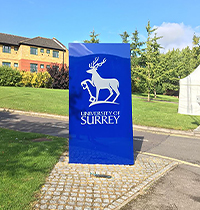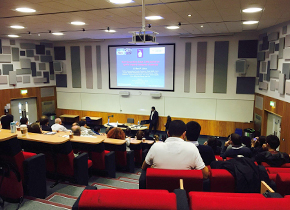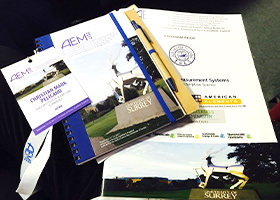AEM2017 is a premier conference series on energy materials, which was held from September 11-13, 2017 at the University of Surrey, England. The conference was organized in six parallel sessions namely: Advanced Energy Materials, Advanced Graphene Materials, Advanced Nano Materials, Hydrogen Energy, Polymer Energy Materials and Solar Energy Materials. Several scientists, student and industry experts from 48 countries have participated in this prestigious conference with more than 280 technical presentations. My presentation was included in Solar Energy Materials session on the last day of the conference.

(a) Entrance of University of Surrey

(b) Plenary talk during the conference
Interfacial Modification of ZnO Nanorods by Mg-doped ZnO Nanoparticles for Efficient Perovskite Solar Cells
Organometal halide perovskites have emerged as the most promising light absorbers for solar cells due to their unique optoelectronic properties. Efficient perovskite solar cells (PSCs) usually employ an electron-transporting layer (ETL) such as TiO2, SnO2 and ZnO. Among these metal oxides, ZnO is seen to be a possible ETL alternative owing to its high electron mobility, low temperature processability and high transparency. In our previous work, we successfully incorporated ZnO nanorods (NRs), which were formed by low temperature water oxidation of Zn thin films, as ETL for PSCs. Herein, we present the surface modification of wet oxidized ZnO NRs by Mg-doped ZnO (MZO) nanoparticles (NPs) to enhance its optoelectronic properties and to suppress carrier recombination at the ZnO/perovskite interface leading to improved photovoltaic performance. Pointed ZnO NRs with a mean diameter of 150 nm were obtained by water oxidation of Zn thin film at 90°C for 8h. This formation can be explained by the corrosion of Zn in the presence of water and dissolved oxygen. As the Zn thin film is oxidized, the reduction of water and dissolved oxygen release OH- ions that in turn will react with Zn2+ ions to form ZnO crystals. After MZO modification, the NRs became visibly rough due to the coating of MZO NPs. Optical transmission spectra show that the samples have similar average transmittance of about 84% (at 600 nm). The small variation in transparency among the samples indicates that this property is insensitive to the amount of Mg dopant. In addition, the calculated band gap increased from 3.28 eV for the unmodified ZnO NR to 3.32 eV for 20% MZO modified ZnO NRs. The concentration of defects increased for higher amount of Mg dopants. Finally, we fabricated PSCs with configuration of ITO/ZnO NR/MZO/CH3NH3PbI3/spiro-OMeTAD/Au and the 10% MZO NPs-modified ZnO NRs achieved the PCEmax of 4%.

Program book and souvenirs from the conference.
I am grateful that I was able to attend such a prestigious conference in my field of research. I learned a lot from the lectures of the plenary and invited speakers. I was amazed by the profound discussions and sharing of knowledge of researchers during presentations to improve each research. A number of my fellow students also asked me about my study, as they became interested with it due to its simplicity and potential for other useful applications. Finally, I would like to express my sincere gratitude to my supervisor Prof. Hisao Yanagi, Nara Institute of Science and Technology and Marubun Research Promotion Foundation for their guidance, experimental and financial support.
